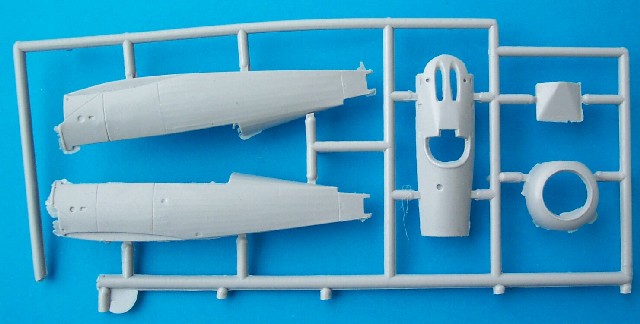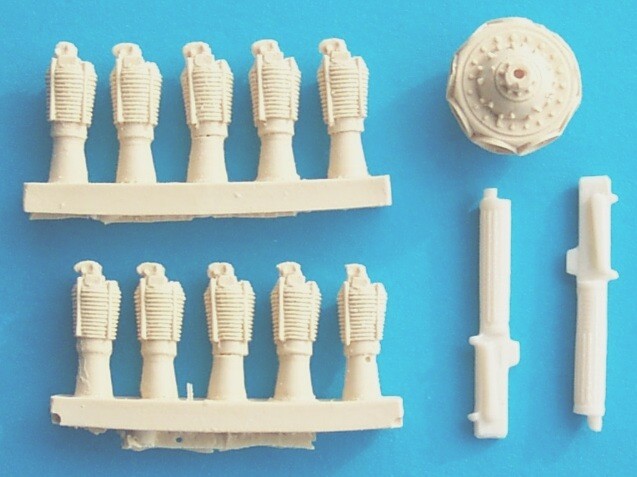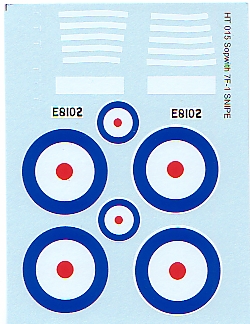S u m m a r y
|
| Catalogue
Number: |
Hi -Tech Sopwith 7F1 “Snipe”
kit HT 015 |
| Scale: |
1/48 |
| Contents and Media: |
19 plastic and 23 pewter alloy
metal parts |
| Price: |
USD$44.96 from Squadron.com |
| Review Type: |
First Look |
| Advantages: |
Ultra thin decals, photo etched
parts, good quality resin, accurate in outline. |
| Disadvantages: |
Poor packaging leads to damage. |
| Recommendation: |
Recommended |
Reviewed by Robert Baumgartner

Hi-Tech's 1/48 scale Sopwith 7F.1 Snipe is available online from Squadron.com
World War 1 aircraft modellers
have never had it better. New kits are being released on a regular basis
and some of these include subjects that one could only have dreamed
about.
Despite this, there are still
many gaps that the “Cottage Industries” can fill.
It has been a while since the
Sopwith “Snipe” last made an appearance in plastic, with the Blue Max
offering being well out of production.
There are forty-two plastic
parts, thirteen in resin (fourteen if you count the broken Vickers gun)
and over seventy photo-etched items. A decal sheet is also supplied
which contains markings for one aircraft only.
Accuracy of the major components
was excellent when compared to the plans by Colin Owers; the ones used
being dated 1996.
As explained on the instruction
sheet, these multi-media kits are not for the novice.
The contents of the box will
give the modeller the essential items to create a sound example but
additional reference material will be needed.

Click the thumbnails below to view larger
images:
Expect your jaw to drop when
opening the box. Inside were the plastic sprues, naked photo-etched
fret, and bagged resin all floating around within the oversized box.
Naturally the p-e is not going to survive very long among the rattling
plastic.
Thus the first step is to bend
the p-e parts back into shape and check for broken resin. My example
produced a busted Vickers gun and detail snapped off five of the ten
cylinders provided: super glue becomes the rescuer, if you can find
these items.
The moulding of the plastic
parts is generally good but they will benefit from a light sanding to
get rid of a slightly rough surface texture in various areas. Some
sprues are common to both this kit and that of the “Salamander” so a
little trimming of the ailerons are needed for the “Snipe”. This is
mentioned in the instructions.
Both types of fin/rudder are
supplied so the builder can deviate from the kit’s chosen scheme.
Each fuselage half is a lot
thinner than expected so there’s plenty of room for the interior. This
consists of some plastic framework, with the floorboards, wicker seat,
belts, handgrip and instrument panel all being photo-etched.
The top wing is assembled in the
same manner as the original: in three pieces.
The flying surfaces are well
formed with subtle rib tapes reproduced on the lower surfaces. Those on
the top should have been the same but unfortunately Hi-Tech chose to try
and replicate too many of the smaller details. The result is 1960’s
Airfix type rivets. Thankfully these are easily removed with a few
swipes of wet and dry paper.
The engine is a lovely piece of
work. This consists of ten pieces of resin (one cylinder being spare)
and the modeller can add the push rods with stretched sprue. Also in
resin are the Vickers guns and the casting of these is matched by the
high standards of the engine.

Photo-etch is used for the finer
items, these being the gun sights, air speed indicator, control horns
and hole reinforcements for the control cables. Not forgotten is
Hi-Tech’s rendition of Barker’s “mascot” that was secured to his
starboard Vickers gun.
Other details are supplied in
this material such as the propeller “boss”, Vickers loading handles, and
footsteps, amongst others.
These are provided
for just one aircraft, that of William G. Barker.
His Sopwith Snipe
E8012 was involved in a fight of unequal odds where Barker is credited
with shooting down a number of German aircraft. It occurred on the 27
October 1918 and although wounded many times the airman was able to
crash-land inside the British lines. For this action, he was awarded the
Victoria Cross.

The decal sheet is
well printed with very thin carrier film. There is a slight registration
problem, which will lead some modellers in search of replacements.
Although
recommended for experienced modellers, this is not due to the kit as
much as it is for the lack of instructions. Deciphering what goes where
will be the biggest hurdle but from there the model should assemble
easily.
It is a competent kit
of a worthwhile subject and as usual with kits of this kind, a little
extra work is expected. Just make sure you have plenty of references
handy.
When opening your
box, be careful as there will inevitably be a piece or two hiding from
its new owner. Seek them out with care.
Recommended
Thanks to
Squadron.com for the review sample.
Review and Images Copyright © 2005 by
Robert Baumgartner
Page Created 05 June, 2005
Last updated 05 June, 2005
Back to HyperScale Main Page
Back to Reviews Page
|
Home | What's
New | Features
| Gallery |
Reviews | Reference
| Forum
| Search